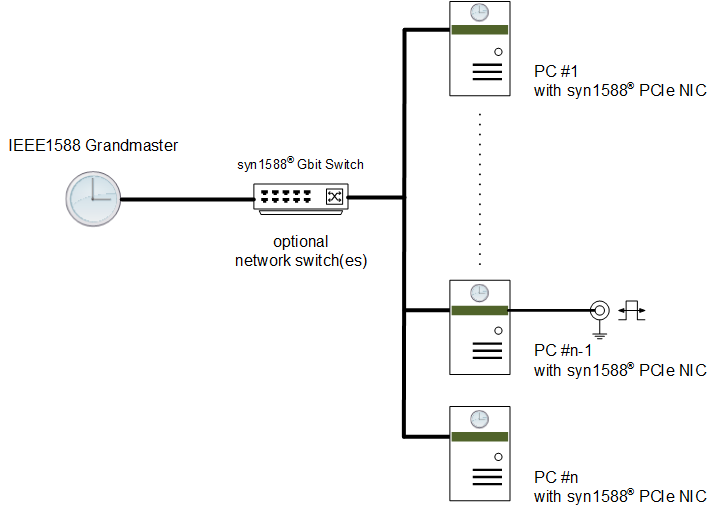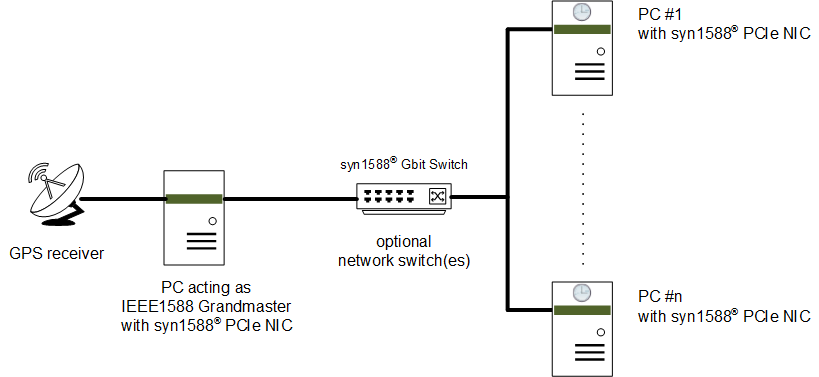This application note describes all available options briefly as well as the related ordering code for ordering the syn1588® PCIe NIC Revision 2.
Download (PDF):
Oregano Systems syn1588® PCIe NIC is a PCI Express Gbit network interface card with IEEE1588 hardware support. A PC equipped with the syn1588® PCIe NIC receives highly accurate time (<10 ns) independent from network utilization and CPU load without real-time requirements for the node’s operating system.
The syn1588® PCIe NIC acts basically as a standard 100/1000 MBit/s Network Interface Card (NIC). Besides the standard function of sending and receiving Ethernet packets, the syn1588® PCIe NIC includes dedicated hardware to implement high accuracy clock synchronization following the IEEE1588 standard.
The syn1588® PCIe NIC includes a full-featured IEEE1588 hardware clock as well as complex timestamping hardware. All time critical elements of an IEEE1588 system are embedded in the syn1588® PCIe NIC thus removing all timing constraints from the software. There are no real-time requirements for the operating system or the software stack. Due to its special structure, the CPU load for the required IEEE1588 stack (e.g. Oregano Systems syn1588® PTP Stack) is negligible.
The syn1588® PCIe NIC had been re-designed to board Revision 2.3 observing the full compatibility on function level. The re-design was required to deal with the excessive lead times of electronic components we are faced with in the whole industry. We took the chance to update the clocking infrastructure on the board to achieve an even better accuracy and stability.
This FAQ document summarizes frequently asked questions and their answers when using the syn1588® PCIe NIC for the first time. Please check this document in case of any issues or unintended behaviour of your system prior contacting the syn1588® support.
This application note describes all available options briefly as well as the related ordering code for ordering the syn1588® PCIe NIC Revision 2.
Download (PDF):
This application note describes the process of running the Precision Time Protocol (PTP) as defined in IEEE1588-2008 on a PC using a syn1588® PCIe NIC.
Download (PDF):
This application note describes the new functions and features of the board revision 2.3 of the syn1588® PCIe NIC
Download (PDF):
This application note describes how to analyze the PTP link status using very simple means to identify frequently configuration issues like IP address misassignments, network issues or firewall blocking the traffic. After running the first simple tests using the syn1588® PTP Stack as described in the syn1588® PCIe NIC Quick Start Guide one starts setting up a real-life PTP system in a more complex scenario.
Download (PDF):
This application note describes how to measure 1PPS signals from different products and vendors. It also explains how the measurement results can be interpreted.
Download (PDF):
This application note describes the procedure for updating the firmware of the syn1588® PCIe NIC to enable new or improved functions.
Download (PDF):
This application note describes how to use the syn1588® System Information Report feature of the syn1588® PTP Stack implemented to facilitate solving installation issues.
Download (PDF):
This application note informs on how to get rid of the buggy altera_cvp driver that comes with Linux kernel version 4.14 and newer.
Download (PDF):
AN023 Issues with Linux kernel version 4.14 and altera_cvp module
Download (ZIP):
This application note describes the capabilities and configuration of the syn1588® event I/Os namely the TRIGGER output, the PERIOD output, and the EVENT input
Download (PDF):
This application note describes the procedure for generating a low-jitter clock signal using the Oregano Systems syn1588® PCIe NIC (Revision 2 or newer).
Download (PDF):
AN008 Generating a low-jitter clock signal with the syn1588® PCIe NIC
The syn1588® PTP Stack supports many PTP profiles with different sync rates and varying requirements for the operation as PTP slaves. This application note helps to select the appropriate basic parameter sets depending on the application and the requirements.
Download (PDF):
This application note describes the procedure for connecting a GPS receiver to a syn1588 NIC® as well as the requirements for selecting an appropriate GPS receiver for IEEE1588 master operations.
Download (PDF):
This application note describes how to use a syn1588® PCIe NIC as a time source for an NTP server.
Download (PDF):
AN029 Using a syn1588® PCIe NIC as a time source for an NTP server
This application note describes in step-by-step examples how to utilize the functions of the Video add-on board for the syn1588® PCIe NIC (Revision 2.1 only)
Download (PDF):
The timestamping unit of the syn1588® Clock_M IP Core used in the syn1588® PCIe NIC allows detecting two independent classes of Ethernet packets in both receive and transmit direction respectively. One packet class in each direction is used for detecting PTP packets and thus used by the syn1588® PTP Stack. The second timestamping unit may be used by the application software to detect an arbitrary class of Ethernet packets in each direction and draw a timestamp upon transmission or reception of a packet meets the user defined filter condition.
This application note briefly outlines the required actions in the user software.
Download (PDF):
This application note describes the function and usage of the redSync utility. This utilty allows to create PTP nodes with redundancy.
Download (PDF):
The syn1588® hardware allows the adoption of the timestamps drawn to the external PHY structure used. While the external delays are constant for many products they might vary for SFP based products depending on the SFP trasnceiver module used.
This application note describes the computation of the PHY delay values for several products, configurations and board revisions.
Download (PDF):
The syn1588® PCIe NIC allows to easily create a standard-compliant IEEE1588 node. For this both
are required. The syn1588® PCIe NIC is plugged into your PC or server. Now, the drivers have to be installed. Finally, the syn1588® PTP Stack has to be invoked on your system to complete the IEEE1588 node. Note, the syn1588® PCIe NIC comes with a binary run-time license of the syn1588® PTP Stack.
PCs equipped with the syn1588® PCIe NIC synchronize their local hardware clock with an accuracy of 10 ns or better to the absolute time information distributed by an IEEE1588 grandmaster.

syn1588® PCIe NIC acting as PTP Slave
A PC equipped with the syn1588® PCIe NIC may act as an IEEE1588 Grandmaster on your network. The syn1588® PCIe NIC may synchronize its local hardware clock to an external absolute time reference like e.g. a GPS receiver.

syn1588® PCIe NIC acting as PTP Master
Oregano Systems provides a utility the – syn1588® PTP Management Software – free of charge that allows users to remotely manage all IEEE1588-2008 nodes in a network.
Please check the Application Note "Ordering syn1588® PCIe NICs" describing the available options for the syn1588® PCIe NIC and their respective ordering number.
Please note that we generally recommend a high quality OCXO oscillator for all IEEE1588 master applications.
You may directly contact Oregano Systems for a quotation or for placing an order. If required we will forward your order or request for quotation to our regional distributor.
Looking for recent software updates? Please contact Oregano Systems‘ support. We will provide you your required updates via our secure download server (SFTP server)
contact@oregano.at
+43 676 84 31 04 -200
+43 676 84 31 04 -300
Franzosengraben 8
1030 Vienna